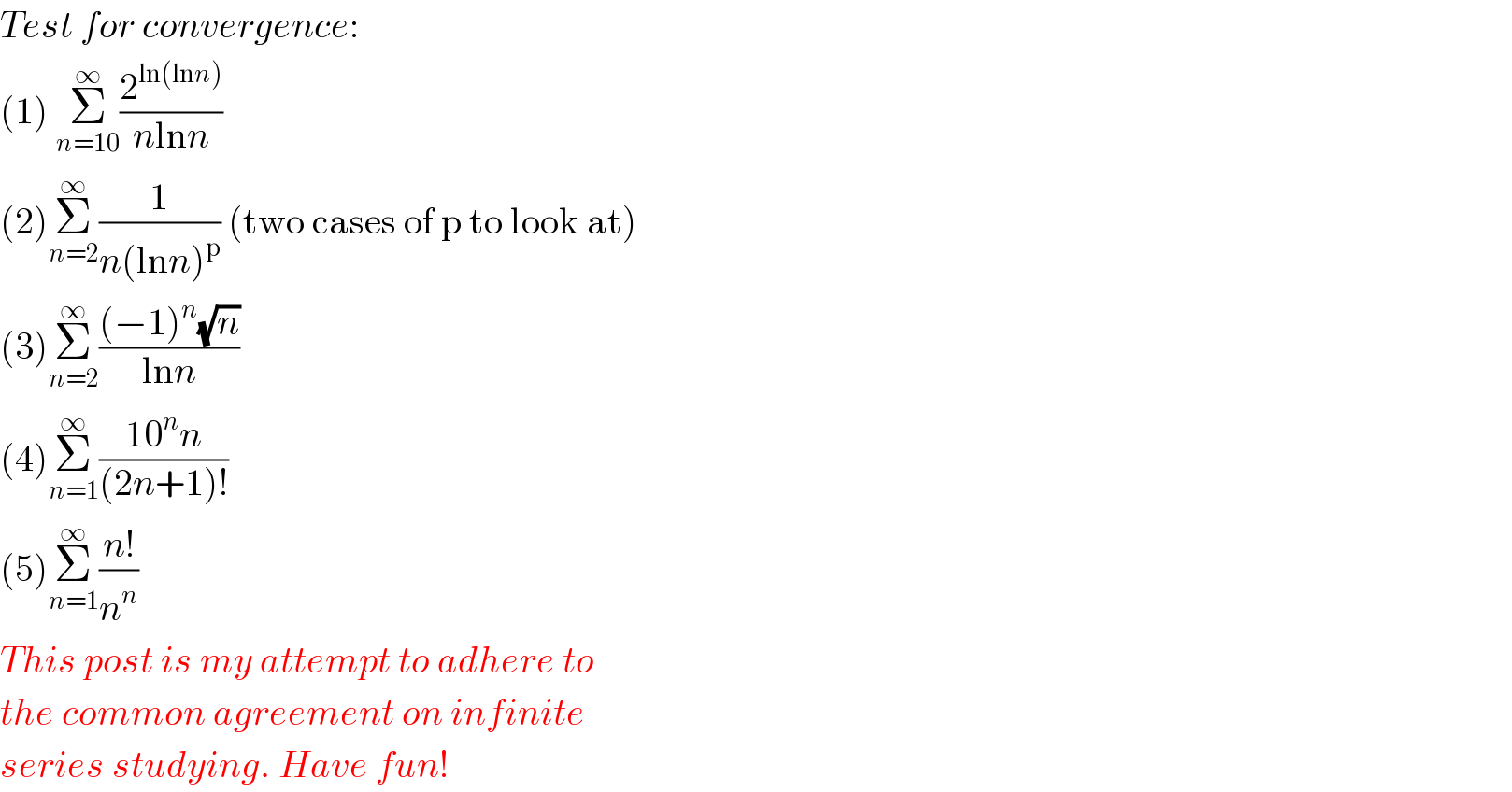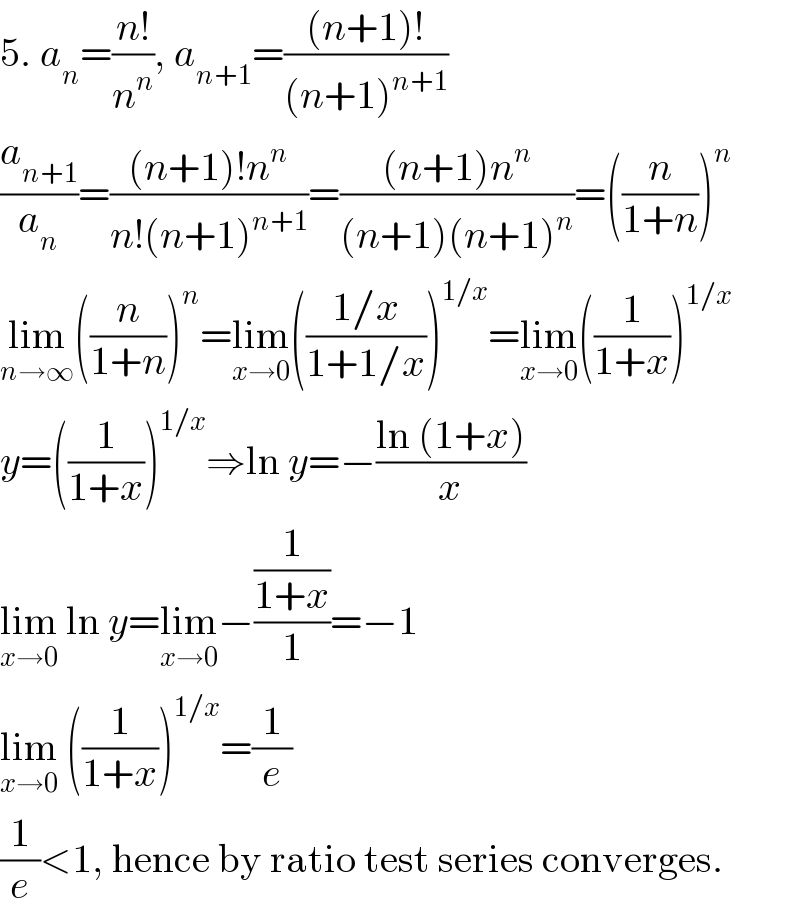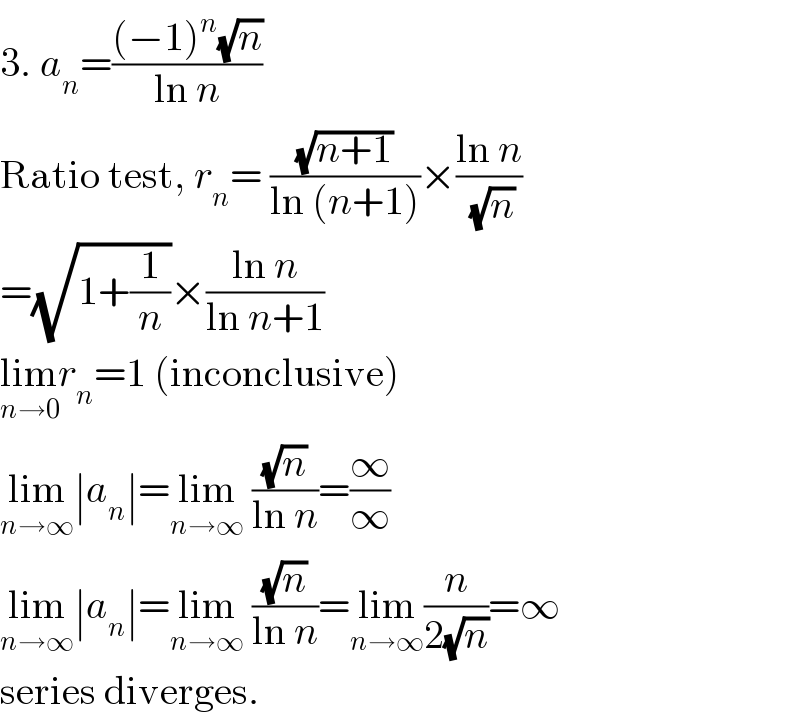Question Number 3564 by Yozzii last updated on 15/Dec/15

$${Test}\:{for}\:{convergence}: \\ $$$$\left(\mathrm{1}\right)\:\underset{{n}=\mathrm{10}} {\overset{\infty} {\sum}}\frac{\mathrm{2}^{\mathrm{ln}\left(\mathrm{ln}{n}\right)} }{{n}\mathrm{ln}{n}} \\ $$$$\left(\mathrm{2}\right)\underset{{n}=\mathrm{2}} {\overset{\infty} {\sum}}\frac{\mathrm{1}}{{n}\left(\mathrm{ln}{n}\right)^{\mathrm{p}} }\:\left(\mathrm{two}\:\mathrm{cases}\:\mathrm{of}\:\mathrm{p}\:\mathrm{to}\:\mathrm{look}\:\mathrm{at}\right) \\ $$$$\left(\mathrm{3}\right)\underset{{n}=\mathrm{2}} {\overset{\infty} {\sum}}\frac{\left(−\mathrm{1}\right)^{{n}} \sqrt{{n}}}{\mathrm{ln}{n}} \\ $$$$\left(\mathrm{4}\right)\underset{{n}=\mathrm{1}} {\overset{\infty} {\sum}}\frac{\mathrm{10}^{{n}} {n}}{\left(\mathrm{2}{n}+\mathrm{1}\right)!} \\ $$$$\left(\mathrm{5}\right)\underset{{n}=\mathrm{1}} {\overset{\infty} {\sum}}\frac{{n}!}{{n}^{{n}} } \\ $$$${This}\:{post}\:{is}\:{my}\:{attempt}\:{to}\:{adhere}\:{to} \\ $$$${the}\:{common}\:{agreement}\:{on}\:{infinite} \\ $$$${series}\:{studying}.\:{Have}\:{fun}! \\ $$
Commented by prakash jain last updated on 15/Dec/15

$$\mathrm{Find}\:\mathrm{sum}\:\mathrm{or}\:\mathrm{only}\:\mathrm{check}\:\mathrm{for}\:\mathrm{convergence}? \\ $$
Commented by Yozzii last updated on 15/Dec/15

$${Do}\:{as}\:{you}\:{please},\:{but}\:{I}\:{only}\:{asked}\: \\ $$$${about}\:{convergence}.\:{If}\:{a}\:{question} \\ $$$${sparks}\:{further}\:{questions}\:{then}\:{fantastic}! \\ $$
Answered by prakash jain last updated on 15/Dec/15

$$\mathrm{5}.\:{a}_{{n}} =\frac{{n}!}{{n}^{{n}} },\:{a}_{{n}+\mathrm{1}} =\frac{\left({n}+\mathrm{1}\right)!}{\left({n}+\mathrm{1}\right)^{{n}+\mathrm{1}} } \\ $$$$\frac{{a}_{{n}+\mathrm{1}} }{{a}_{{n}} }=\frac{\left({n}+\mathrm{1}\right)!{n}^{{n}} }{{n}!\left({n}+\mathrm{1}\right)^{{n}+\mathrm{1}} }=\frac{\left({n}+\mathrm{1}\right){n}^{{n}} }{\left({n}+\mathrm{1}\right)\left({n}+\mathrm{1}\right)^{{n}} }=\left(\frac{{n}}{\mathrm{1}+{n}}\right)^{{n}} \\ $$$$\underset{{n}\rightarrow\infty} {\mathrm{lim}}\left(\frac{{n}}{\mathrm{1}+{n}}\right)^{{n}} =\underset{{x}\rightarrow\mathrm{0}} {\mathrm{lim}}\left(\frac{\mathrm{1}/{x}}{\mathrm{1}+\mathrm{1}/{x}}\right)^{\mathrm{1}/{x}} =\underset{{x}\rightarrow\mathrm{0}} {\mathrm{lim}}\left(\frac{\mathrm{1}}{\mathrm{1}+{x}}\right)^{\mathrm{1}/{x}} \\ $$$${y}=\left(\frac{\mathrm{1}}{\mathrm{1}+{x}}\right)^{\mathrm{1}/{x}} \Rightarrow\mathrm{ln}\:{y}=−\frac{\mathrm{ln}\:\left(\mathrm{1}+{x}\right)}{{x}} \\ $$$$\underset{{x}\rightarrow\mathrm{0}} {\mathrm{lim}}\:\mathrm{ln}\:{y}=\underset{{x}\rightarrow\mathrm{0}} {\mathrm{lim}}−\frac{\frac{\mathrm{1}}{\mathrm{1}+{x}}}{\mathrm{1}}=−\mathrm{1} \\ $$$$\underset{{x}\rightarrow\mathrm{0}} {\mathrm{lim}}\:\left(\frac{\mathrm{1}}{\mathrm{1}+{x}}\right)^{\mathrm{1}/{x}} =\frac{\mathrm{1}}{{e}} \\ $$$$\frac{\mathrm{1}}{{e}}<\mathrm{1},\:\mathrm{hence}\:\mathrm{by}\:\mathrm{ratio}\:\mathrm{test}\:\mathrm{series}\:\mathrm{converges}. \\ $$
Answered by prakash jain last updated on 15/Dec/15

$$\mathrm{4}.\:{a}_{{n}} =\frac{\mathrm{10}^{{n}} {n}}{\left(\mathrm{2}{n}+\mathrm{1}\right)!}\:\Rightarrow\:\:\frac{{a}_{{n}+\mathrm{1}} }{{a}_{{n}} }=\frac{\mathrm{10}\left({n}+\mathrm{1}\right)}{{n}\left(\mathrm{2}{n}+\mathrm{2}\right)\left(\mathrm{2}{n}+\mathrm{3}\right)} \\ $$$$\underset{{n}\rightarrow\infty} {\mathrm{lim}}\:\frac{\mathrm{10}\left({n}+\mathrm{1}\right)}{{n}\left(\mathrm{2}{n}+\mathrm{2}\right)\left(\mathrm{2}{n}+\mathrm{3}\right)}=\mathrm{0} \\ $$$$\mathrm{series}\:\mathrm{converges} \\ $$
Answered by prakash jain last updated on 15/Dec/15

$$\mathrm{3}.\:{a}_{{n}} =\frac{\left(−\mathrm{1}\right)^{{n}} \sqrt{{n}}}{\mathrm{ln}\:{n}} \\ $$$$\mathrm{Ratio}\:\mathrm{test},\:{r}_{{n}} =\:\frac{\sqrt{{n}+\mathrm{1}}}{\mathrm{ln}\:\left({n}+\mathrm{1}\right)}×\frac{\mathrm{ln}\:{n}}{\:\sqrt{{n}}} \\ $$$$=\sqrt{\mathrm{1}+\frac{\mathrm{1}}{{n}}}×\frac{\mathrm{ln}\:{n}}{\mathrm{ln}\:{n}+\mathrm{1}} \\ $$$$\underset{{n}\rightarrow\mathrm{0}} {\mathrm{lim}}{r}_{{n}} =\mathrm{1}\:\left(\mathrm{inconclusive}\right) \\ $$$$\underset{{n}\rightarrow\infty} {\mathrm{lim}}\mid{a}_{{n}} \mid=\underset{{n}\rightarrow\infty} {\mathrm{lim}}\:\frac{\sqrt{{n}}}{\mathrm{ln}\:{n}}=\frac{\infty}{\infty} \\ $$$$\underset{{n}\rightarrow\infty} {\mathrm{lim}}\mid{a}_{{n}} \mid=\underset{{n}\rightarrow\infty} {\mathrm{lim}}\:\frac{\sqrt{{n}}}{\mathrm{ln}\:{n}}=\underset{{n}\rightarrow\infty} {\mathrm{lim}}\frac{{n}}{\mathrm{2}\sqrt{{n}}}=\infty \\ $$$$\mathrm{series}\:\mathrm{diverges}. \\ $$
